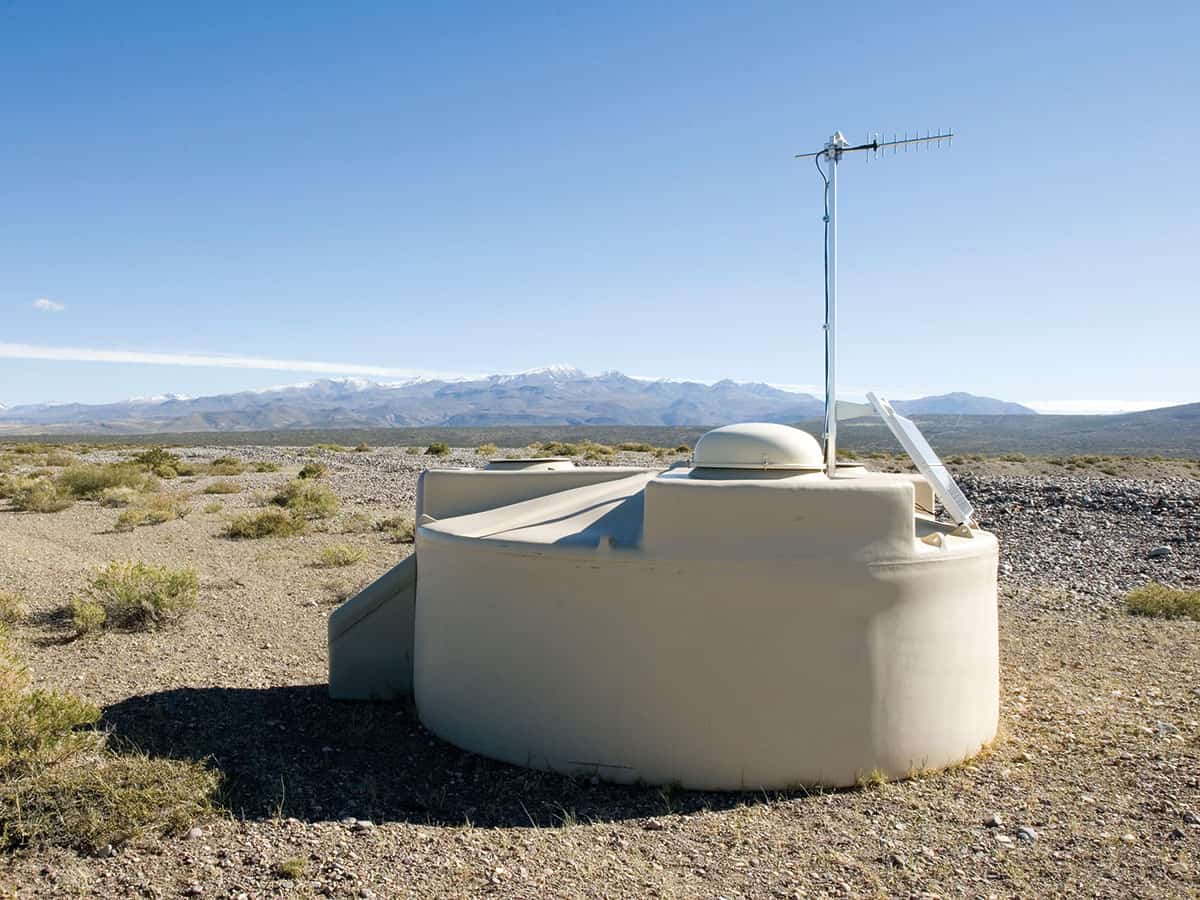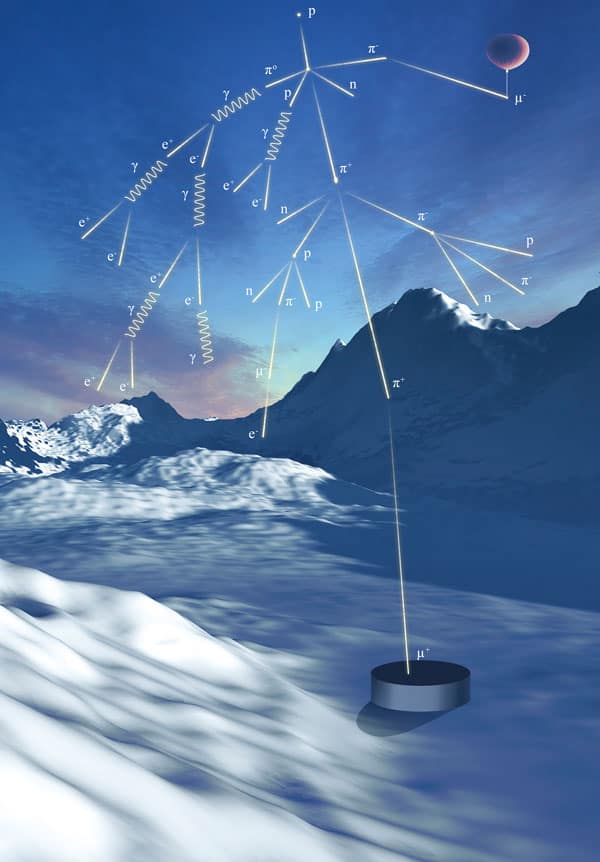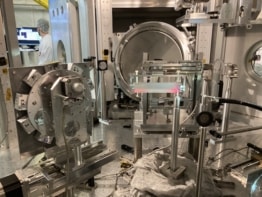Ultrahigh-energy cosmic rays are the most energetic and rarest of particles in the universe – and also one of the most enigmatic. Benjamin Skuse reveals how cosmic-ray mysteries are continuing to test our understanding of high-energy physics
Far, far away, something – somewhere – is creating particles with crazy amounts of energy. Whatever they are or wherever they’re from, these particles can be anything between 1018 eV and 1020 eV. Given that the top particle energy at CERN’s Large Hadron Collider is about 1013 eV, some of these particles are a million times more energetic than anything we can fashion at the most powerful particle accelerator on the planet. Quite simply, they’re the most energetic particles ever seen in nature.
Known as ultrahigh-energy cosmic rays (UHECRs), these particles were discovered in 1962. They’re the super-energetic brethren of common-or-garden cosmic rays, which were first spotted by Austrian scientist Victor Hess during a famous series of daring hot-air balloon flights 50 years earlier. But while we know a great deal about regular cosmic rays, what UHECRs are made from, where in the heavens they come from and what accelerates them remain a mystery.
Fortunately, some UHECRs occasionally rain down on planet Earth. When one such ray enters the atmosphere, it collides with air molecules, which in turn knock into other particles, resulting in a cascade effect all the way to the ground. The result is a shower of particles spread over an area 5 km wide at the Earth’s surface. And thanks to the Pierre Auger Observatory in Argentina and the Telescope Array in Utah, we can detect these showers and extract information about the cosmic rays themselves.

Both facilities consist of an array of surface detectors – in the case of Auger, 1660 large barrels each with over 12,000 litres of water spread across 3000 km2. When a particle from a shower flies into a detector, it creates an electromagnetic shockwave that’s picked up by light-detecting tubes mounted on the detector’s tanks. Researchers can then combine this information with data from 27 telescopes dotted throughout the array that collect the fluorescence light created when the cascade excites nitrogen in the air.
This combined technique yields an accurate measure of the flux, arrival direction and energy of the UHECRs. And last year, as a result of this work, Pierre Auger researchers unequivocally showed that the most powerful cosmic rays come from outside the Milky Way, not from within our galaxy (Science 357 1266). Considering we’ve known about cosmic rays for over a century, this breakthrough may seem underwhelming and a bit overdue. In reality, though, it reflects the gargantuan challenge researchers face. Cosmic rays with an energy above 1020 eV land – on average – just once per square kilometre on Earth per century.
Cosmic rays with an energy above 1020 eV land – on average – just once per square kilometre on Earth per century
What are UHECRs made of?
Data gathered over decades prove that low-energy cosmic rays – which are mostly protons, nuclei and electrons – appear to come from all directions in the sky. Scientists attribute this spread to the rays being deflected in all directions by the magnetic fields that permeate our galaxy, which rules out all hope of ever zeroing in on their source directly. UHECRs are another matter. They power through galactic magnetic fields so well that they are deflected by only a few degrees. “We can use them as astronomical messengers to find the sources directly,” explains Ralph Engel, spokesperson for the Pierre Auger Observatory.
During a UHECR air shower, the cascade effect involves more and more particles as the shower scythes through the atmosphere. However, each interaction loses energy, which means that the number of shower particles starts to decline, with only a small fraction reaching the ground. But by knowing how the air shower spreads in the atmosphere, Auger and Telescope Array researchers can simulate the particle interactions to deduce where in the atmosphere the shower was at its peak. And by combining the shower peak value with the measured shower energy, they can infer the mass – and thus the identity – of the UHECRs.
When Auger scientists applied this method, they expected the highest-energy UHECRs to be simply made of protons. Instead, they found something strange. As the energy of the UHECRs increased from 1018 eV to 1020 eV, so did the mass. “We start with a lot of protons around 1019 eV,” explains Engel. “Then all of a sudden, there’s a drastic change to helium [nuclei] and then elements in the range of carbon and nitrogen.”
The increase of the UHECR’s mass as the rays get more energetic is a problem for both experimentalists and theorists. What’s tricky for Auger scientists is that heavier UHECRs get deflected more by the Milky Way’s magnetic fields, which makes it even more challenging to work out their source. For theorists like Vasiliki Pavlidou of the University of Crete, on the other hand, the problem is more fundamental: it could challenge our entire understanding of high-energy physics. “If the primary particles at the highest energies are indeed getting heavier, there are a couple of uncomfortable coincidences that we have to accept,” she says.

According to conventional wisdom, cosmic rays above a certain energy rapidly lose energy as they interact with photons in the cosmic microwave background, which means that the energy of UHECRs seen on Earth ought to be limited to about 1020 eV. However, if the observed particles are getting heavier with energy, then the astrophysical process that’s accelerating the cosmic rays in the first place – whatever it is – must be running at close to its top energy. (The lighter particles will then be simply too puny to reach those high energies.) The 1020 eV UHECR energy limit is therefore governed by two completely unrelated processes: how the particles are accelerated at their extragalactic source and how they lose energy as they travel through interstellar space. That’s the first odd coincidence.
The second coincidence is to do with cosmic rays from within our galaxy and those that come from elsewhere. It seems that galactic cosmic rays stop being observed at 3 × 1018 eV – exactly the same energy at which extragalactic cosmic rays start getting heavier with energy. That’s strange given that galactic and extragalactic cosmic rays come from very different sources (even if we still don’t know where the latter originate).
Given that these two coincidences depend on processes and properties that are not even vaguely related, why are they happening at the same energy scales? One reason could be that these coincidences simply do not exist. That would certainly be the case if extragalactic cosmic rays don’t get heavier with energy but are just always protons; the coincidences would then just fade away. Indeed, Pavlidou and her Crete colleague Theodore Tomaras reckon that UHECRs could be mainly protons, the only snag being there would have to be some new undiscovered physical phenomenon that affects the air showers above a certain energy.
That may sound outlandish, but there’s good reason to not reject the idea outright. Physicists model how the particles in the air shower interact based on their understanding of the Standard Model of particle physics, but it has never been tested (even at the LHC) at such high energies. Moreover, these simulations fall far short of explaining all the air-shower properties observed. So you have two unpalatable choices. Either cosmic rays are protons and new physics is making them appear heavy. Or UHECRs are heavy particles and the Standard Model needs some serious tweaking.
But if UHECRs are protons, figuring out how protons could be masquerading as heavier particles will require some alternative thinking. One exciting possibility is that the proton’s initial collision produces a mini black hole, the existence of which is predicted by theories with large extra dimensions. “For the right number of such dimensions they can actually have the desired mass,” explains Tomaras. “Mini black holes would decay instantaneously to a large number of hadrons sharing the black hole energy, making the proton primary ‘look’ heavy.”

Looking at the sky from under water
Another alternative would be to invoke the existence of as-yet-undiscovered phases of quantum chromodynamics (QCD) – the theory that describes how quarks are bound inside protons, neutrons and other hadrons. Tomaras admits, however, that these are “exotic” scenarios. “We have not yet discovered large extra dimensions,” he says, “and we have reasons to suspect that the production cross section of mini black holes will most likely be too small to serve our purpose and, furthermore, we do not have a robust quantitative understanding of the phases of QCD yet.” However, if proof surfaces of UHECRs being protons, Tomaras believes it is “almost inevitable” that such exotic phenomena occur in nature.
What accelerates them?
Leaving aside the lack of certainty surrounding what UHECRs are, the question that really matters is: what makes them? Here, the picture is even more muddled. Until recently, some physicists were exploring exotic ideas known as “top-down models” that go beyond the Standard Model. The idea is that high-energy, unknown objects such as super-heavy dark matter – with masses 1012 times larger than the proton mass – would decay down to UHECR particles. The catch with these models is that they suggest cosmic rays should be dominated by photons and neutrinos, whereas data from the Pierre Auger Observatory, Telescope Array and elsewhere suggest mostly charged particles. “Nobody tries to build exotic models of the classic top-down set-up anymore,” explains Engel.
Although the exotic dark-matter scenario hasn’t been totally ruled out as the source of UHECRs, researchers are more seriously contemplating if extremely violent astrophysical events might instead be responsible for such high energies. Pulsars, gamma-ray bursts, jets from active galactic nuclei, starburst galaxies and others have been proposed, with popular opinion swaying between them.
Roberto Aloisio from the Gran Sasso Science Institute in Italy believes that on face value Auger’s results – suggesting heavier UHECR particles at the highest energies – are an important development. “It is easier to accelerate heavy nuclei than protons because the acceleration mechanisms always feel the particles’ electric charge – and nuclei heavier than protons always have larger electric charge,” he explains. As a result, Aloisio suggests Auger points towards pulsars as the source of UHECRs, which produce heavier elements and could drive these particles to the required energy (Prog. Theor. Exp. Phys. 2017 12A102).
Currently, however, there is one candidate that is ahead of all others as the source of UHECRs. “If I had to bet I would definitely put all my money into starburst galaxies,” says Luis Anchordoqui of the City University of New York, who is a member of the 500-strong Auger team. Starburst galaxies are the most luminous in the universe, forming stars at a furious rate. As Anchordoqui and colleagues first hypothesized in 1999, nearby starburst galaxies accelerate nuclei to ultrahigh energies through a collective effort, combining numerous supernovae explosions in the central dense region of the galaxy to create a galactic-scale “superwind” of outflowing gas.
As this superwind expands, it becomes less dense, slowing flow down to subsonic speed – in effect, halting the progress of the superwind itself. “This produces a gigantic shock wave, similar to the one produced after the explosion of a nuclear bomb, but much more powerful,” says Anchordoqui.
Crucially, this process of diffusive shock accelerator, or DSA, can whip up gas particles to near the speed of light. Particles gain energy incrementally by being confined by magnetic fields, and crossing and recrossing the shock front. Going round and round the astrophysical accelerator, these little energy boosts build up until the particle reaches escape velocity and flies out into space. Anchordoqui recently revisited the work in the context of Auger’s latest findings (Phys. Rev. D 97 063010).
DSA, which does not only occur in starburst galaxies, is often invoked to explain proposed particle acceleration in gamma-ray bursts, active galactic nuclei and other UHECR source candidates. Yet in early 2018, Kohta Murase and his collaborators from Penn State University showed that a different acceleration mechanism could be at play (Phys. Rev. D 97 023026).
In their model, ordinary cosmic rays existing in a particular galaxy are given a huge energy boost by powerful jets of active galactic nuclei, through a mechanism known as discrete shear acceleration. It is a complex process involving the interaction between the particle, local disturbances in the magnetic field and the velocity difference – or “shear” – of different parts of the jet’s flow and ambient cocoon. But in the end the effect is similar to DSA. “The cosmic rays gain energy via scattering back and forth around the shear boundary,” explains Murase, after which they escape through the radio lobes that are often found at the end of the jets.
Even more recently, Murase and Ke Fang from the University of Maryland (Nature Phys. 14 396) revisited an idea that powerful black hole jets in aggregates of galaxies could be powering UHECRs. To begin, they compared their model to Auger’s observed UHECR flux and composition data, revealing a good match with experimental observations. But most intriguingly, they showed that by detailing how UHECRs, neutrinos and gamma rays might all be produced by active galactic nuclei, they could explain the data collected by the IceCube Neutrino Observatory in Antarctica, Fermi Gamma-ray Space Telescope and Auger simultaneously. “The most beautiful possibility is that all three messenger particles originate from the same class of sources,” Murase adds.
Where do they come from?
If we knew where in the sky UHECRs come from, the task of choosing which source produced them would be a lot easier. But there is no such thing as “easy” in cosmic-ray science. Undaunted, Auger and Telescope Array scientists use catalogues of potential candidate objects that could accelerate UHECRs and then try to match them with the arrival directions of the cosmic rays they observe. As more and more data arrive, both facilities have each identified an area from which a big proportion of these rays seem to originate.

In the case of Auger, this area contains a number of starburst galaxies, but also Centaurus A – the nearest giant galaxy to the Milky Way that hosts an active galactic nucleus. As for the Telescope Array, its “hot spot”, which lies just beneath the handle of the Ursa Major constellation, is an even clearer indication of an arrival direction, with a quarter of detected UHECR signals coming from a 40° circle that makes up only 6% of the sky. But although the starburst galaxy M82 resides in the hot spot, about 12 million light-years away in Ursa Major, various other types of objects in that patch of sky could also be a UHECR birthplace.
“The correlation is in the direction of M82 if you want to say it’s starburst galaxies, or it’s the direction of Centaurus A, if you want it to be active galactic nuclei,” says Engel. “Although the data correlate better with starburst galaxies, it doesn’t mean that they will be the sources.”
Just as we don’t know what UHECRs are or what accelerates them, so where in the sky they originate is shrouded from view too. However, it may not be long before we find the answer. Upgrades to the Pierre Auger Observatory and the Telescope Array are in progress, while researchers are exploring new facilities, such as the Probe of Extreme Multi-Messenger Astrophysics (POEMMA) satellites.
The mystery of the mass and origin of these enigmatic particles could, within a decade, finally be laid bare.
- Enjoy the rest of the August 2018 issue of Physics World in our digital magazine or via the Physics World app for any iOS or Android smartphone or tablet. Membership of the Institute of Physics required




